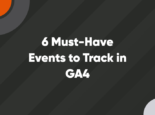
How to Rank Higher in Search Results: SEO Traffic to Revenue Series

You've created a great piece of content. You put in the work researching keywords. But how do you get your page positioned at the top of SERPs?
Welcome to the second blog in our SEO Traffic to Revenue series, where we'll discuss the best practices for improving your content's position in search results. If you missed our first blog, feel free to go back and read about how to identify focus keywords before moving on to this blog.
When it comes to improving rank, there are some key factors that directly contribute to a higher position. Focusing on what you can control and optimizing your pages will help you better your rank, and in turn, increase your traffic.
Here are some recommended optimizations for increasing page position on SERPs and growing your website's visibility. We'll break it down into actionable optimizations you can make to show up when your audience is searching for you.
Page structure
Page structure is extremely important for search engines that are crawling content, and also for general readability. If a reader doesn't understand your page hierarchy or has a hard time navigating through the content, the search engine will, too. Make it as easy as possible for users to consume your content and for search engines to crawl it.
Here are a few easy ways to add structure:
- Utilize headers to break up sections of text and add page hierarchy
- Section text with bullet points
- Separate text with visuals or white space
- Create click paths with internal links and buttons to aid navigation
- Layout your site in a pleasing way
- Strike a balance of imagery and text
- Use strong CTAs
Internal links
Internal links are like the street signs of your website, giving users directions on where to go next. They improve site navigation for users and search engines. Internal links also give you some control over your users' navigational path. If you use internal links regularly, search engines will have a much easier time crawling your site and indexing content.
Here are a few internal linking tips:
- When you create a new piece of content, like a blog post, make sure to link to any pre-existing, relevant content in that post. You should also update pre-existing content to include the link to the new post
- Try to spread links throughout your page
- Make sure to edit the link text to give readers an understanding of where they're navigating to
- Try to include at least 3 internal links in every new blog post
Visuals
Visual elements bring life to a page. Without visuals, visitors might leave your site simply out of boredom. Break up text with images that complement the topic.
Whenever you add visuals, ensure you're also adding the proper alt text. Alt text makes images more accessible to users with disabilities and gives the search engine context as to what the visual is. And given that approximately 1 in 4 Americans lives with some form of disability, you don't want to leave out that portion of your audience.
Try to vary your visuals by using:
- Videos
- Infographics
- GIFs
- Animations
Optimized content
You've probably heard it many times, but in 2023, unique, quality content is still the name of the game.
Differentiate your brand from your competitors by providing your audience with helpful content that's relevant to their pain points, helps them solve a problem, or entertains them.
Make sure you're optimizing your content by using a few strong keywords.
Here are some content tips:
- Conduct research on a topic your audience cares about
- Share insights or experiences that prove your credibility
- Create unique content, like videos, infographics, case studies, etc.
- Go behind the scenes by introducing your team or breaking down processes
- Share your company's unique selling points
Backlinks
Using a link-building strategy to build your website's authority can go a long way in improving your rank. This can be time-consuming and might take a while to pay off, but over time, link-building can make a huge impact.
Most backlink strategies require cold-emailing and guest blogging, which can be a long, tiresome game. Be selective about the sites you choose – make sure they're relevant to your content and that they are credible and authoritative.
If you're just getting started, you'll likely need to focus on reaching out to potential backlink opportunities. Think about any strong business relationships you can leverage and start there.
Mobile-friendly website
It's 2023. If your website isn't mobile-friendly, you're playing catch-up.
More users than ever before are conducting searches from their phones, meaning if your site isn't compatible with mobile, you're missing out on lots of potential site traffic. If your site experience is poor on mobile, visitors will leave your site and find another one that offers a better experience.
Mobile-first sites also rank better because of accessibility factors, so it's a win-win to update your site.
Page speed
How fast does your website load? Does it take a while to navigate from page to page?
Page speed is important to Google and to site users. Slow page speed not only deters users from staying on a site but also deters search engines from crawling and indexing web pages.
Here are a few quick fixes for a slow website:
- Remove unnecessary plugins
- Compress images
- Reduce redirects
Give search engines a push to index
An important piece of the SEO puzzle is getting your web pages indexed. While search engines crawl your website each day, they don't always make it through to the new content you post. Internal linking helps with this, but companies are still limited by a crawl budget that dictates how many web pages a search engine will crawl in a day.
To make sure a search engine crawls your new page, you can request indexing from Google Search Console and Bing Webmasters. These tools are also convenient for checking if any of your existing site pages aren't currently being indexed and requesting indexing for those pages.
Implement a dedicated SEO strategy with Perrill
This list isn't exhaustive, and to improve your content's position and keep a high rank, you'll need to continuously work on SEO. It requires a robust strategy that's always changing to reflect competition and relevancy. Rank isn't everything when it comes to generating traffic, but it's a great way to increase visibility and credibility online.
If you could use a hand in making these website optimizations, reach out. We're happy to create a custom SEO strategy integrated with other areas of digital marketing to make sure you see measurable results.
The next step in the process of increasing SEO revenue is improving the clickthrough rate – we'll meet you at the next post!

Grace Hallen
Author
Grace Hallen
Categories
Date
Explore with AI
Join Our Newsletter


Why Google Shouldn’t Reveal Its Search Algorithm


8 Signs You Need a Website Redesign


